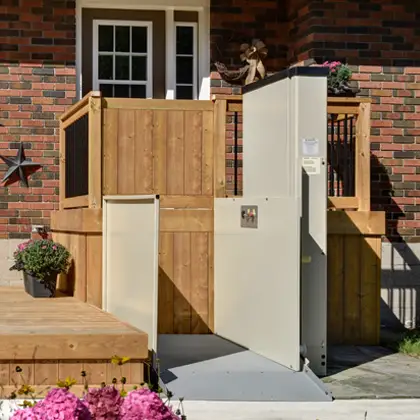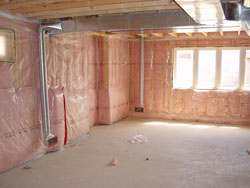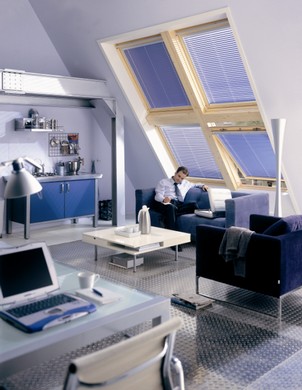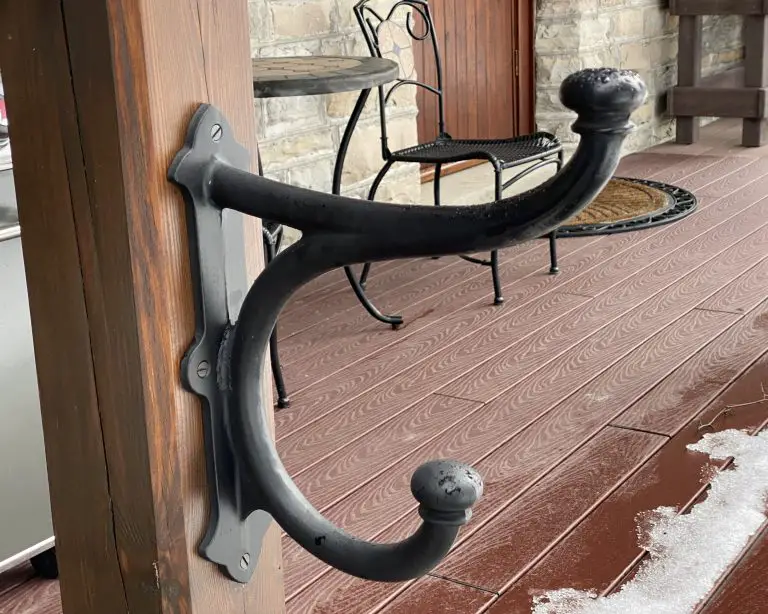I’ve been advising a senior couple lately, Susan and Ian, helping them decide exactly how to renovate their home so they can age well in place, with no need to ever move into a nursing home. This kind of consultation is part of my Aging Well at Home coaching program, and one of the first things we looked at was something called a “porch lift”. This is a little outdoor elevator made to raise and lower a wheelchair or walker from the ground to a porch or verandah, all with no need for a ramp. Porch lifts are very helpful for making a home completely accessible, and in this article I explain how porch lifts work, and how to get a good one installed. Click below for a video tour or porch lifts, then read on for more details.
- Video Watch Time = 6 minutes
A vertical electric outdoor lift is a reasonable alternative to a ramp, and it offers several unique advantages. In Susan and Ian’s case, we’re installing a lift at the front of the house, but also building a ramp in the backyard as an alternative to the lift.

Most vertical porch lifts work the same way and look similar. A movable platform with a door sits at ground level. Open the door, roll or walk onto the platform, then close the door behind you and hit the activation button. The lift will rise and stop automatically at the upper limit of its preset travel. Open the door, then roll or walk out. Outdoor vertical lifts are in the same family as home elevators and stair lifts, but I’ll focus on vertical porch lifts here exclusively.
All About Porch Lifts

Unlike a wheelchair ramp, installing an outdoor vertical lift is something that’s usually handled by specific professionals. That’s because it’s mostly a unique mechanical installation job, not fabrication as with a built-on-site wooden ramp. As you shop for a lift, keep these points in mind:
- What a lift is officially called: The technical term for what you’re looking for is a “residential vertical platform lift”. Lifts rated for commercial or public use are built to meet additional standards not required for residential situations. Typical residential-grade wheelchair lifts can raise and lower up to about 60 or 70 vertical inches. Some go higher than this, but situations like these are more in the realm of residential elevators.
- Preparation needed before installing a lift: Although all vertical outdoor lifts operate in a similar way, the footprint they require you to have for a lift can vary a bit. Some models need a concrete pad while others might need a pit underneath for mechanicals for a hoist above.
- Connect with a trustworthy dealer: Since installing a lift is about mechanics, wiring and code requirements, I recommend finding a dealer you like, then let them present you with the options. You’ll still need to have think about where you want your ramp to be.
- Railing & gate: Whatever kind of porch or verandah your lift is connected to, you’ll need some kind of railing and gate around the perimeter. Even a deck that’s normally too close to the ground still requires a railing when a wheelchair will be on it. A gate is also required for the top of the porch to block the entrance into the lift when the lift is at a lower level. Some lift systems come with a top gate, while others require a wooden gate built on site.
- Tech specs, warranty and quality: Most residential wheelchair lifts can safely handle 600 to 750 lbs. with a 50-inch to 70-inch overall vertical lift capacity. For lifts higher than this, you should look at what are called “outdoor elevators”.
- Cost: In the case of Susan and Ian, a lift that makes sense for them costs just under $9K (Canadian dollars), with about 40% coming back in the form of tax credits. It’s surprising how many jurisdictions offer financial breaks to seniors for age-related home renovations. There isn’t even any sales tax on the lift that Susan and Ian will be putting in.
- Lift speed: This refers to how quickly the unit rises under load. You’ll find 10 to 12 feet per minute (FPM) and common speed. So if your porch is 3 feet higher than the surrounding ground, then it will take roughly one-third of a minute to go from down to up, and the same back down again.
- Alarms: Some lifts have a built-in audible alarm system that can be activated manually in case of trouble.
- Battery backup: A grid power failure can happen at any time, and battery backup is all about keeping your lift working while the power is down. Batteries typically charge through the same outlet that powers the lift during normal use.
Are you serious about staying in your home during your golden years? Want to avoid the nursing home altogether? Click here or below to learn more about my Aging Well at Home program. It’s for seniors everywhere who want the most out of life.













